Lovely blooms in my Garden this morning.
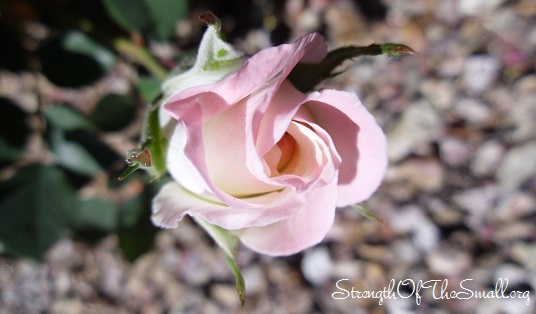
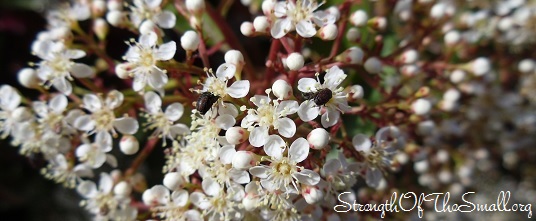
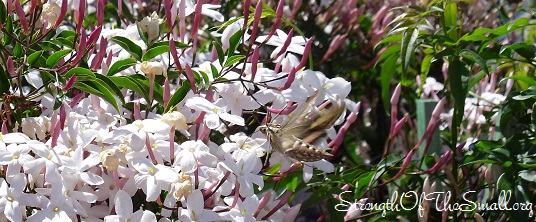
I hope you all had a blessed and beautiful day.
Finding Contentment in Every Situation
Finding Contentment in Every Situation
Lovely blooms in my Garden this morning.



I hope you all had a blessed and beautiful day.
I am so excited for the weekend. There are a couple of events coming up. On Saturday, we will be taking the kids to The Home Depot® Kids Workshop and this time, the kids will be building Bird Feeders. These are free Do-It-Yourself Workshops which are available for adults/homeowners as well.
On Friday we’ll be attending the 29th Annual High Desert Home & Garden Show which will be held at the Victorville Fairgrounds on April 5, 6 and 7, 2013. We’ve heard great stories about the Home & Garden Show, but never found the time to attend. We already have our tickets which mean peace of mind.

Address Location:
San Bernardino County Fairgrounds
14800 Seventh Street, Victorville, CA 92395
1 (760) 951-2200
Days and Times:
Friday: 1:00 PM to 7:00 PM
Saturday: 10:00 AM to 6:00 PM
Sunday: 10:00 AM to 5:00 PM
Admission:
General: $6.00
Seniors: Free Friday
Children: under 18 free with paying adult
Parking: Free
Coupons: Daily Press
If for some reasons you cannot attend this event, a second one will be held on November 1, 2 and 3, 2013.
Visit the Event website for more information.
When it comes to garden edging the possibilities are endless to meet your needs. You can choose from Plastic, Bricks, Rocks, Boulders, Bamboo, Wrought Iron/Metal, Bottles, Wood, Plates to Concrete and so much more.
Those with limited to no budget can look around their property for garden edging ideas. Do you have scrap wood, dead branches, pine cones, rocks or decorative bricks lying around in your yard? If you do, by all means put them to use. Those of us with trees of all types around our properties know that Nature has a way of stressing them to the breaking point such as:
» The weight of ice and snow
» Strong winds
» Dead branches
» Lack of nutrients
» Old age
» Plant disease (fungal infections), … etc!
What can we do with a fallen branch or a broken tree? For one, we can safely remove the fallen branch and dispose of it and/or contact an arborist to remove the fallen tree. We can use the wood for your fireplace, fire pit, as borders in your garden, and so much more.
The 2008 winter storm was so severe that it split two of my mature trees in two.
After removing and disposing of most of the branches, I kept a few branches from my broken pine tree which I am now using as plant borders.
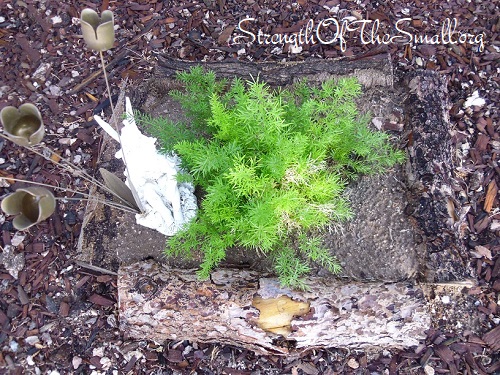
Our preferred garden edgings are the Plastic edging and Terrace Board Landscape edging.
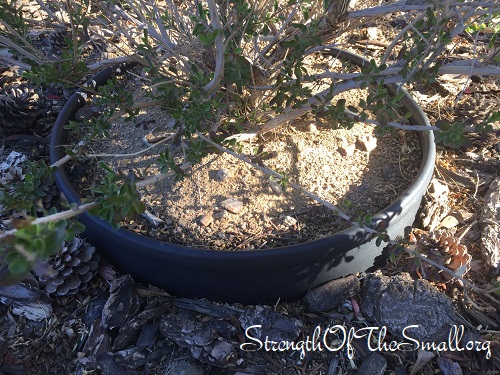
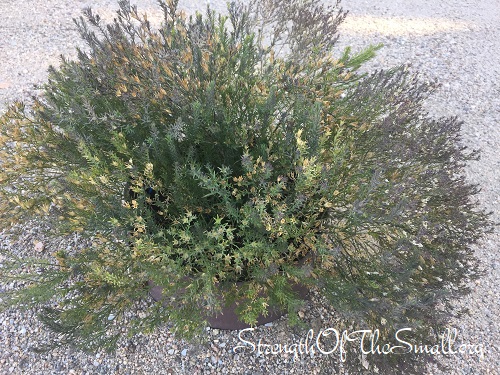
I have used pine cones as plant borders for a few years now and I have placed a lot around my plants and garden beds to deter squirrel from digging. So far, it has worked for me.
Happy Gardening and wishing you a good start into the week.
What a lovely day in the garden today! I spent part of my afternoon tending to my plant and preparing a location for an outdoor Dining Table we will be building soon. I love the way everything is coming together. I replaced a couple of plants in the backyard with some I bought from Lowe’s® and The Home Depot® (Shrubs, Succulents, Mini Roses, etc). I wasn’t the least surprised to find Curl Grubs beneath the roots of the plants.
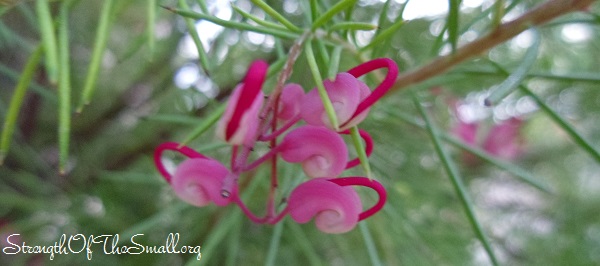
My evergreen Grevillea ‘Noellii’ is thriving on the side of the house in a very large ceramic planter we received from a wonderful neighbor. We placed it a few feet away from one of our bedroom windows and it’s always a delight watching it every morning. The plant is blooming with tiny lovely pink & white flowers.

Rosemary! Had it not been for the stray cats I was trying to keep out from my property, I wouldn’t have fallen in love with this plant. I have always known of its culinary and medicinal uses, but I had never thought of using it as a decorative plant in my garden. I love its aroma and its delicate small blue flowers (they’ve always bloomed from Sprint to Fall). My next project will be to propagate as many as possible.
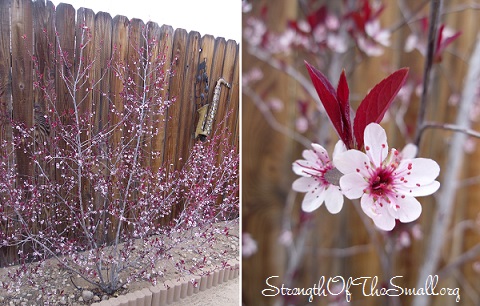
Above is my Purple Leaf Cherry Plum all in bloom and looking lovely. I picked it up at Lowe’s in 2010 at the discounted area, almost dead. I spent so much time and energy caring for it and I honestly wasn’t sure it would survive, but it did to my amazement and I am so grateful.
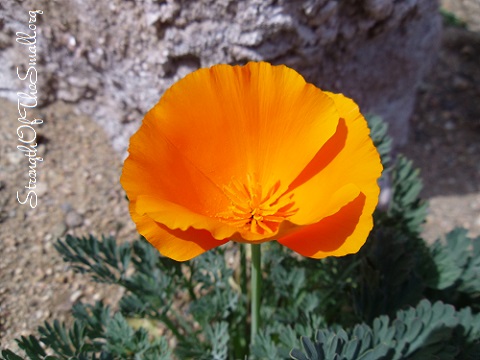
Back in 2008, my husband got me some California Poppies and for some reason they didn’t make it (I guess it probably had something to do with the fact that he brought them from a different location and the poor plants couldn’t handle our harsh weather). Last December, after helping one of my next door neighbors to complete a task, he agreed to give me a couple California Poppies growing in his yard. I transplanted them right away and they are now flowering. I love the bright silky yellow flowers. Click here to learn about its uses, side effects and interactions.
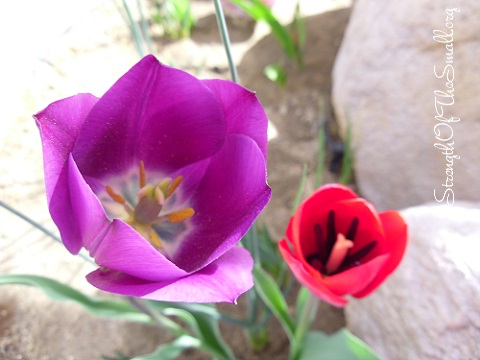
The Tulip bulbs I planted last Fall are starting to bloom. It was a pleasant surprise to wake up this morning and discover two gorgeous flowers staring back at us. My Daughter is so excited. She has a whole raised garden bed of her own which we planted last Fall as well and she is looking forward to seeing some beautiful blooms soon.
Today I finally pulled out what was left of my Snow White Tea Tree in my backyard. I have been suspecting for a while now that something wasn’t right with the plants and decided to give them a few more weeks. It turns out that some White Curl Grubs were happily and vigorously feeding on the roots of the plants which resulted in the plant’s death. I also pulled out what was left of my Crimson Rose Tea Tree which I was growing in a barrel in my front yard. They were beautiful drought-tolerant plants and a wonderful addition to my garden. I have had those plants for four years and every year, during this time, they would be covered in blooms.
It seems like every time I loose a plant in my garden, I get blessed with a new one from my garden. Just a few weeks ago, I discovered a Rose sucker around the base of one of my favorite Rosebush. Last year I gained two more Roses using the propagation by simple layering method. This year on the other hand, my ‘Little Pete’ Rose Tree has a Sucker which is rapidly growing just a small distance from the mother plant. I carefully removed it along with its roots and transplanted it in a pot to create a new Rosebush. My first thought was to just separate the sucker and the mother plant and allow both to grow along side, but I quickly realized that the space between both wasn’t enough to allow them to thrive. It’s such a beautiful Rose and I hope my new growth survives.
Click here, here and here to learn about Propagation by Simple and Tip Layering.
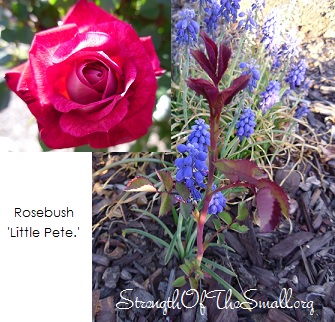
On a much happier note, we are weed free! I will blog about it in a different post and let you know how we got rid of weeds on our half-acre property in less than two weeks (using just a hoe, rake and a hand shovel).
Happy gardening!